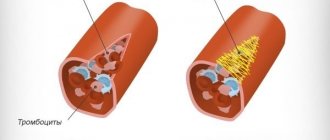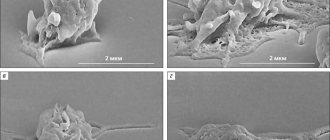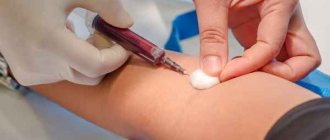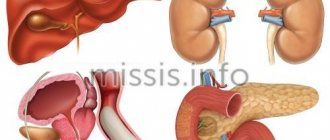Thrombocytopenia is a pathological condition of the body, which is characterized by a decrease in the number of platelets in the bloodstream and is accompanied by increased bleeding.
Scientists say that thrombocytopenia is quite common. On average, this is from 10 to 130 cases, out of 1000 blood tests. (https://nbuv.gov.ua/UJRN/simmed_2017_2_28).
Normally, a healthy person has 150-320*109/l platelets in the blood. Their main task is to respond to any damage to the integrity of the skin or mucous membranes. They go to the site of injury, are activated and begin to form small blood clots, which close the gap. But there are diseases that lead to a decrease in the number of these cells.
This can occur by causing pathological destruction of platelets, problems with the formation of new ones and increased use of existing cells.
Thrombocytopenia can occur as an independent disease or as a separate symptom of various diseases that affect the blood coagulation system.
General information
Platelets are granulocytic blood cells without a biconvex nucleus, formed from plasma cells of the bone marrow. They are presented in different forms - young, adult and mature. The diameter is directly proportional to age: 2-4 microns. Platelets contain granules that create blood clotting proteins, lytic enzymes, phosphatase and cathepsin, create serotonin, calcium ions and ATP, and contain lysosomal enzymes.
One of the most important functions of blood platelets is participation in blood clotting (primary hemostasis).
Platelets bind clotting factors, making blood clots thicker. As a rule, in an inactive state, when the vessel wall is damaged, platelets are directed to the damaged area. Thanks to the pseudopods located on the surface of the body, they are attached to each other and the vascular wall, forming a blood clot, which is an excellent barrier to bleeding. In the active state, platelets are able to change the shape of the body, due to which they increase their area, and this allows them to completely close the damage.
In addition, platelets are able to protect the body from foreign bodies by catching them with the help of pseudopods, and then digesting them with the help of the enzyme lysocine, which is formed from platelet factors (thrombin, thromboxane), from platelet granules. Thus, platelets are important for the immune response, being “killer” cells for foreign agents entering the body.
Blood plates serve as a storage site for serotonin, providing antitumor and radioprotective effects.
Thus, a violation of the number of platelets leads to inhibition of their functions, this certainly leads to disruption of the body’s activity and entails negative symptoms.
Where to get a blood test for PDW
We have no doubt that you take your own health seriously and value the quality of life that is possible in the absence of disease. Blood tests are one of the good and useful habits, and you are a frequent visitor to the laboratory of your favorite medical clinic. It is recommended to undergo a check-up at least for the basic parameters of blood composition and quality at least twice a year.
If we talk directly about the study of the width of platelet distribution, this index is a mandatory part of the OAC for the platelet formula and is submitted to any medical center. clinic.
Perhaps there is no time to visit a doctor for no reason, solely for preventive purposes, so we offer a more convenient way: the tests will be carried out in one of the laboratories of medical clinics, but the collection of biomaterial will be carried out at your home in a calm environment for you or at a specified location .
- Sterile;
- Personnel of the highest category with medical education and work experience;
- Up to 50 research parameters;
- Free with bioniq BALANCE subscription
Information from the analysis is a priority principle for creating a personalized complex of micronutrients, vitamins needed specifically at the current moment.
Normal platelet count in blood
The number of platelets in the body should normally vary from 180 to 320*10^9 for women and from 200 to 400*10^9 for men per liter of blood. Moreover, the number of platelets in women can change during menstruation to 75 * 10^9 per liter of blood, can decrease in the third trimester in pregnant women and, regardless of gender, increase in response to an inflammatory reaction, which seems to be a physiological norm and is not a deviation, without carrying negative symptoms.
In children, the normal platelet count depends directly on the age of the child. For a newborn, the norm will be 100-420*10^9 per liter of blood, and at two weeks of age and up to a year it is 150-350*10^9 per liter of blood. Up to five years, the amount changes slightly to 180-350*10^9 per liter of blood. By the age of seven, the norm reaches 180-450*10^9 per liter of blood.
For prevention, you need to take a blood test at least once a year in order to identify a possible pathology as early as possible and begin its treatment as soon as possible at an early stage, before the development of a severe clinical condition. If a deviation is detected, a blood test is performed more often.
They live in the body for only 9-10 days, after which they are renewed, destroyed in the liver or spleen and re-proliferate in the bone marrow.
Online consultation with infectious disease specialist, allergist-immunologist Natalia Nikolaevna Gordienko
Cost of online consultation: 3500 rubles
Online consultation
During the consultation, you will be able to voice your problem, the doctor will clarify the situation, interpret the tests, answer your questions and give the necessary recommendations.
Why platelets may be low
Sometimes thrombocytopenia is inherited, from parents to child. This is not a disease, but a feature of the body.
But more often the platelet count decreases Thrombocytopenia (low platelet count) - Symptoms and causes / Mayo Clinic for one of three reasons.
The body retains platelets in the spleen
This happens Thrombocytopenia: Causes, Symptoms & Treatment / Cleveland Clinic in people with an enlarged spleen. Normally, it filters unwanted substances from the blood. But when it malfunctions, it can also retain platelets.
The body produces fewer platelets than needed
Platelets, like other blood cells, are produced in the bone marrow. His activity and health can be affected by:
- leukemia and other types of cancer;
- some types of anemia;
- persistent viral infections such as hepatitis C or HIV;
- radiation and chemotherapy. These procedures are often prescribed to treat cancer;
- excessive alcohol consumption.
The body uses or breaks down platelets faster than normal
It happens:
- during pregnancy, and approximately 5% of expectant mothers develop Thrombocytopenia: Causes, Symptoms & Treatment / Cleveland Clinic right before birth; mild thrombocytopenia for unknown reasons;
- for severe bacterial infections;
- for autoimmune diseases, such as systemic lupus erythematosus or rheumatoid arthritis;
- with thrombotic thrombocytopenic purpura, when bruises suddenly form throughout the body, which attract a large number of platelets;
- with hemolytic-uremic syndrome, due to this rare disease, the number of platelets sharply decreases, red blood cells are destroyed and kidney function is impaired;
- due to taking certain medications, including sulfonic antibiotics, anticonvulsants, and blood thinners (anticoagulants).
Causes of low platelet count in blood test
A decrease in the number of platelets in a general blood test below normal to 150*10^9 per liter of blood and below is a pathological condition and is called “thrombocytopenia”. Since this is a condition, not a disease, it only characterizes, being a symptom of a specific disease.
There can be many reasons for a decrease in platelets, and they are all different from each other, so it can sometimes be very difficult to name one at once.
The main causes of thrombocytopenia are:
- Increased platelet destruction.
- Increased platelet consumption.
- Insufficient platelet production.
These three conditions can be the result of an inherited condition in which enzyme activity is impaired, but more often it is an acquired condition due to:
- Suppression of bone marrow activity.
- Hemoblastosis (tumor disease of hematopoietic or lymphoid tissue).
- Disseminated vascular coagulation syndrome (due to various bacterial infections or brain injury).
- Vitamin B12 deficiency.
- Folic acid deficiency.
- Hypersplenism syndrome (an increase in the size of the spleen, as well as an increase in the destruction of blood cells).
- Hemorrhagic diathesis (increased bleeding).
- Immune thrombocytopenia.
- Thrombocytopenic purpura.
- Leukemia (malignant disease of the bone marrow, otherwise called blood cancer).
- Paroxysmal nocturnal or cold hemoglobinuria.
- Collagenosis (connective tissue damage).
Additional reasons for a decrease in platelets in the blood may also be:
- Violation of medication regimen (vancomycin, heparin, sulfamethoxazole, drugs for the treatment of diabetes mellitus).
- Use of chemotherapy drugs.
- Massive blood transfusion.
- Cirrhosis of the liver.
- Myelofibrosis.
- Hepatitis C virus.
- Human immunodeficiency virus (HIV).
- Epstein-Barr virus (infectious mononucleosis).
- Hyperthyroidism.
- Hypothyroidism.
- Hemolytic-uremic syndrome.
- Alcoholism.
Symptoms of thrombocytope
All symptoms of thrombocytopenia are associated with bleeding and manifest themselves as follows:
- Frequent nosebleeds that occur without good reason. This can be a simple runny nose, sneezing, blowing out the nose, or during gentle touching of the nasal mucosa.
- Involuntary bruising. Even at the site of the slightest blow, bruises form that take a long time to disappear.
- Appearance of purpura. Red spots on the skin or mucous membranes. They do not hurt, do not itch, and most often appear at the site of friction with clothing or as a result of microtrauma.
- Bleeding gums. After eating hard food or brushing your teeth, even with the softest brush, your gums begin to bleed.
- Bleeding in the gastrointestinal tract. The mucous membrane of the stomach and intestines is thin and quite delicate, so a decrease in platelets can lead to the appearance of blood in the stool or even vomiting.
- The appearance of blood in the urine. The walls of the ureters, kidneys or bladder may bleed.
- Heavy and prolonged bleeding during menstruation. It can appear both during the first menstruation in a girl and over time in an adult woman.
- Weakness, fatigue, headache, dizziness, decreased physical activity, pale skin, bruises under the eyes, shortness of breath. Blood performs a transport function in the body, and in the case of a decrease in platelets, and as a result of bleeding, which will lead to a decrease in the amount of blood in the body. Thus, the brain, muscles, heart and other organs do not receive enough nutrients and oxygen.
The manifestations and activity of symptoms depend on the severity of thrombocytopenia, which characterizes the number of platelets in the blood.
Severity of thrombocytopenia:
Light degree - from 50 to 150 *109/l. Most often, there are no obvious symptoms, and a low platelet level is diagnosed during preventive examinations or treatment of concomitant diseases.
Average degree - from 30 to 50 *109/l. General symptoms of malaise, irregular and mild bleeding due to injuries, which is difficult to stop
Severe degree - below 30 *109/l. Spontaneous and heavy bleeding into internal organs, inability to stop bleeding without hospital treatment.
Consequences of low platelet count
In a state of low platelet count, disorders subsequently develop, which include frequent bleeding (menstrual and nosebleeds), while the bleeding time increases significantly and becomes difficult to stop. Sudden gum bleeding may develop (not everyone does). Blood clots may be found in urine or stool. Petechiae (red dots resulting from damage to the capillary wall) appear on the skin of the lower extremities, most often the legs. Even minimal damage leads to the formation of ecchymoses (bruises), when normally a bruise would not appear.
The severity of symptoms directly depends on the platelet count. The fewer platelets, the more severe the clinic. If the platelet count is very low, internal bleeding into the digestive tract or even bleeding into the brain may occur.
Even in the presence of a mild clinic, it is recommended to consult a general practitioner in order to prevent this condition.
Diagnostics
Since there are so many reasons, it is not possible to name diagnostic measures in detail - everything will depend on the specific situation. But we can highlight the main components of diagnosis:
- General blood analysis.
- Checking bleeding time (Duke test).
- Determining the time it takes for blood to clot.
- Red bone marrow puncture. The method allows you to identify quantitative and qualitative changes in cells.
- Determination of antibodies in blood.
- Research for genetic diseases.
- Ultrasound of internal organs. Most often, the liver and spleen are studied immediately, but this list can be very large.
- MRI. Used to study internal organs and blood vessels.
Diagnosis of the disease begins with a visit to a general practitioner, who, based on a survey, initial examinations and tests, prescribes visits to other specialists.
Platelet diagnostics
At the first appearance of relevant clinical symptoms (bleeding and bruising), it is necessary to consult a specialist, in this case it is a general practitioner. There is no need to postpone going to the doctor until the clinic gets worse, because in this case the treatment will be more difficult and the outcome will be less favorable.
To diagnose thrombocytopenia, you must first take a blood test. If the analysis reveals a low platelet count, the general practitioner may refer you to a hematologist, who will prescribe additional tests, such as:
- Coagulogram with determination of clotting time.
- Blood biochemistry for LDH, ASAT, ALAT and bilirubin.
- Antibody test.
- MRI.
- Ultrasound of the abdominal organs.
- Genetic studies (to exclude hereditary thrombocytopenia).
After conducting research and identifying the true cause of thrombocytopenia, a general practitioner or hematologist prescribes appropriate treatment, which includes eliminating the cause of the decrease in platelet count.
Online consultation with infectious disease specialist, allergist-immunologist Natalia Nikolaevna Gordienko
consultation cost: 1000 rubles
Online consultation
During the consultation, you will be able to voice your problem, the doctor will clarify the situation, interpret the tests, answer your questions and give the necessary recommendations.
Classification of thrombocytopenia
Let's talk about the causes of thrombocytopenia that underlie the different types of this disease.
Hereditary thrombocytopenias
These conditions are based on diseases of genetic origin. These may be May-Hegglin anomaly, Bernard-Soulier syndrome, Wiskott-Aldrich syndrome, TAR syndrome, as well as congenital amegakaryocytic thrombocytopenia.
Each of these diseases has many characteristics. For example, Wiskott-Aldrich syndrome occurs exclusively in boys and occurs in four to ten cases per million. Bernard-Soulier syndrome can only develop in a baby who has received the altered gene from both parents, and May-Hegglin anomaly can develop in 50% of cases, provided that only one parent has the prerequisites for this. As a rule, all of these diseases have among their symptoms not only a low level of platelets, but also a number of other pathological conditions, and therefore require special treatment.
Prevention
There is no specific prophylaxis for thrombocytopenia. It is recommended to lead a healthy lifestyle, including proper nutrition, normal sleep, not to overload yourself with work, abstain from drinking alcohol and tobacco products, treat infectious diseases in a timely manner and carry out routine vaccinations. Consult a doctor promptly if there is a sudden disturbance in the body’s functioning.
Author: infectious disease doctor. Allergist-immunologist Natalia Nikolaevna Gordienko











